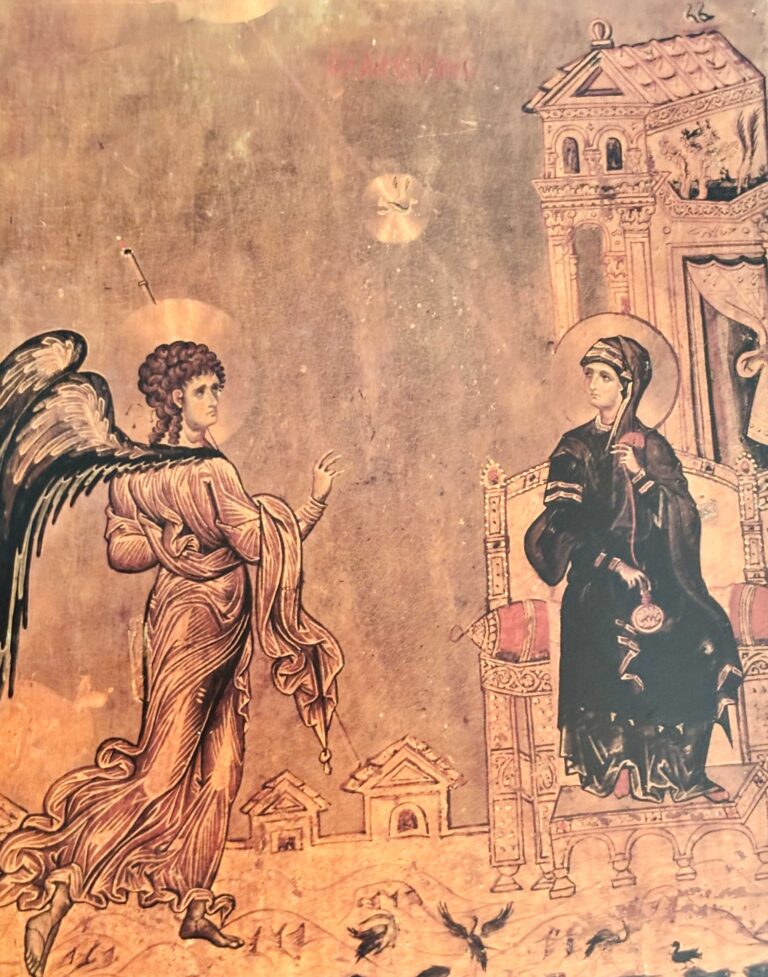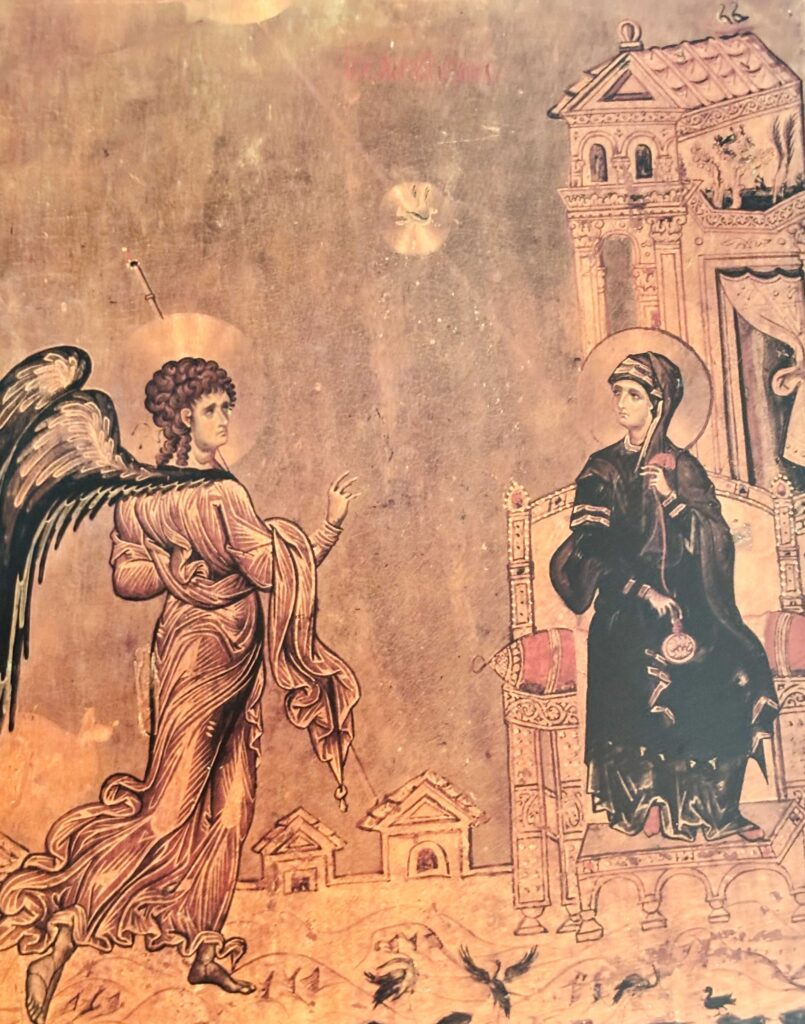

A Anunciação – Monastério Santa Catarina no Sinai – séc XII
Ícones do Mosteiro de Santa Catarina
Museu do Mosteiro de Santa Catarina
Iguaria:
O Ícone da Anunciação no Mosteiro de Santa Catarina no Sinai, Egito, é um ícone bizantino incomum atribuído ao final do século XII.
O ícone da Anunciação é um exemplo do estilo tardio da era Comnena e provavelmente foi produzido em Constantinopla sob julgo latino.
O ícone, têmpera sobre madeira, é um dos maiores ícones em exposição no Mosteiro de Santa Catarina.
Ícones da Anunciação muito semelhantes existem para ajudar a estabelecer a data do ícone do Sinai.
Um está em Kurbinovo na Macedônia do Norte, datado de 1191, e o ícone em Lagoudhere em Chipre, datado de 1192.
O ícone possui elementos distintivos que levam historiadores da arte, a sugerir que o ícone pode ter sido produzido no próprio Mosteiro de Santa Catarina, e não em Constantinopla.
O ícone da Anunciação compartilha características encontradas exclusivamente em outros ícones sinaítas, como os círculos refletivos gravados na superfície do ouro e o medalhão de grisalha dourada com o Menino Jesus no peito da Virgem Maria.
A composição destaca a Encarnação, com foco no Espírito Santo descendo “em forma de pomba” dentro de um disco de ouro, e o Menino diáfano sobre o peito da Virgem, sendo este último um tema iconográfico bastante raro.
A paisagem aquática também é bastante singular e deriva principalmente de hinos eclesiásticos.
Uma peça excepcionalmente sofisticada, o ícone é notável por seu tom dourado saturado e naturalismo.
As cores são usadas com moderação; azuis e roxos profundamente saturados adornam as vestes da Virgem e também são usados nas pontas das asas do Anjo Gabriel.
Discos giratórios aumentam o efeito brilhante do ícone.
A pose de Gabriel imita a Mênade clássica em forma e estilo, e pode ser uma alusão do artista bizantino a Tucídides ou Homero.
Gabriel se aproxima da Virgem com um passo fluido e rápido. Gabriel está vestido com vestes douradas esvoaçantes, feitas com estrias que revigoram a vestimenta do anjo.
A expressão do anjo Gabriel foi descrita como intensamente perturbada enquanto ele olha para o rosto triste da Virgem, antecipando suas tristezas.
Representar a Virgem Maria em um cenário paisagístico, com o rio a seus pés, é excepcional na arte bizantina.
A Virgem, sentada majestosamente em seu trono, segura em sua mão esquerda o tecido vermelho do véu do templo.
O menino Jesus é pouco visível, traçado por uma mandorla ou nimbo de ouro, sobre a parte superior do corpo da Virgem.
Maria toca o bebê no útero, com a mesma mão segurando o material vermelho, ligando o Véu do Templo a Cristo.
Esses detalhes iconográficos enfatizam a retórica teológica do ícone.
A Virgem parece esguia e frágil, olhando um tanto apreensiva para o anjo que se aproxima.
O artista bizantino embelezou o Ícone da Anunciação com motivos de primavera e fertilidade.
O rio está repleto de várias criaturas aquáticas.
Os motivos da primavera retratam pássaros fazendo ninhos nos telhados, árvores brotando folhagens, o rio fluindo livre do inverno, sob o sol dourado brilhante.
O simbolismo da fertilidade é refletido pelo par de cegonhas no telhado e pelo rio repleto de peixes, lembretes visuais de que a concepção de Cristo ocorreu na primavera.
A data primaveril da Festa da Anunciação encorajou escritores e artistas a conectar o tema da festa com representações simbólicas naturais de renovação.
Além do rio, gradações de fundo dourado se misturam aos edifícios arquitetônicos dourados no ícone.
Acredita-se que os edifícios mais baixos no primeiro plano representam Nazaré, a cidade natal da Virgem Maria.
A casa dourada da Virgem é uma elegante estrutura em estilo de igreja.
O véu de casamento exibido na janela está puxado para trás.
No topo da casa da Virgem há um jardim no terraço que faz alusão à retórica do Cântico dos Cânticos (4, 12) e está associado à virgindade de Maria.
A casa da Virgem reflete a fertilidade simbolizada pelas duas cegonhas aninhadas no topo do telhado.
Fonte: Texto traduzido do verbete “ícone da anunciação do Sinai”
Icon of Annunciation of Sinai:
The Annunciation icon is highly stylized and is striking for its unique emotional and dramatic quality. An exceptionally sophisticated piece, the icon is notable for its saturated golden tone and naturalism.
Colors are used sparingly; deeply saturated blues and purples adorn the Virgin’s garments and are used on the tips of the Angel Gabriel’s wings as well.
The remainder of the icon is finished in gold grisaille.
Rotating discs enhance the glittering effect of the icon.
The Holy Spirit and Word of God, symbolized as the dove surrounded by the shimmering gold medallion, is shown descending upon the Virgin Mary.
Gabriel’s pose imitates the classical Maenad in form and style, and may be the Byzantine artist’s allusion to Thucydides or Homer.
Gabriel approaches the Virgin with a fluid running step.
Gabriel is attired in flowing gold robes, done in striation that invigorates the angel’s garment.
The Angel Gabriel’s expression has been described as intensely troubled as he looks into the sad face of the Virgin, anticipating her sorrows.
Depicting the Virgin Mary in a landscape setting, with the river at her feet, is exceptional in Byzantine art.
The Virgin, sitting regally upon her throne, holds in her left hand the red fabric of the temple veil. The infant Christ is barely visible, traced by a gold mandorla or nimbus, upon the Virgin’s upper body.
Mary touches the baby in utero, with the same hand holding the red material, linking the Veil of the Temple to Christ.
These iconographic details emphasize the theological rhetoric of the icon.
The Virgin appears slender and frail, looking somewhat apprehensive at the approaching angel.
The Byzantine artist has embellished the Annunciation Icon with motifs of spring and fertility.
The river teems with various aquatic creatures.
Spring motifs depict birds nesting on the rooftops, trees sprouting foliage, the flowing river freed from winter, underneath the golden glowing sun.
Symbolism of fertility is reflected by the pair of storks on the rooftop and the river alive with fish, visual reminders that Christ’s conception was at springtime.
The spring date of the Feast of the Annunciation encouraged writers and artists to connect the feast’s theme with natural symbolic representations of renewal.
Beyond the river, gradations of gold background blend into the golden architectural buildings on the icon.
The lower buildings in the foreground are thought to represent Nazareth, the hometown of the Virgin Mary.
The Virgin’s golden house is an elegant church style structure. The marriage veil displayed in the window is drawn back.
Atop the Virgin’s house is a rooftop garden alluding to the rhetoric of the Song of Solomon (4:12) and is associated with Mary’s virginity.
The Virgin’s house reflects fertility symbolized by the two storks nesting atop the roof.
Link dos artigos:
Link da fonte:
Divulgado por

Consulte a Agenda do Museu a partir de 2025 e o visite quando receber sua confirmação de visita em seu email ou whatsapp.
Por se tratar de um museu particular, é necessário se cadastrar na Comunidade MuMi e customizar sua visita.
Criação e Tecnologia: Clayton Tenório @2025 MuMi – Museu Mítico